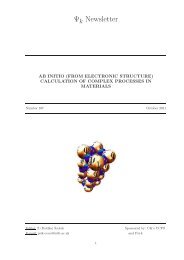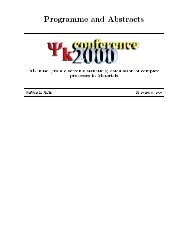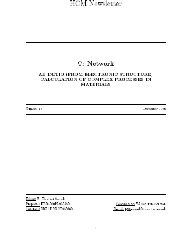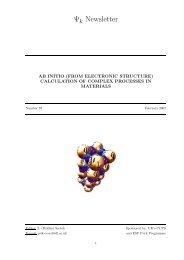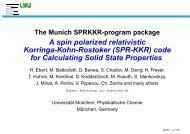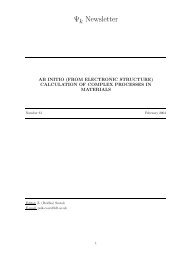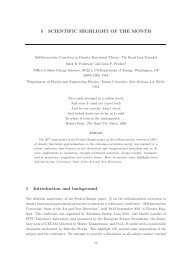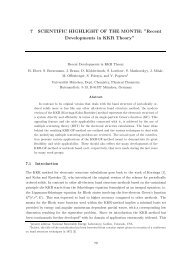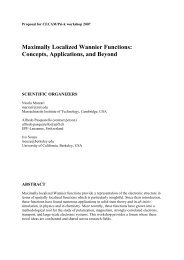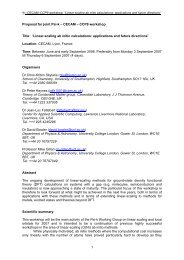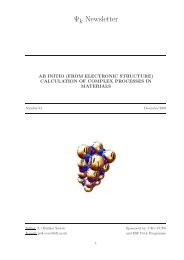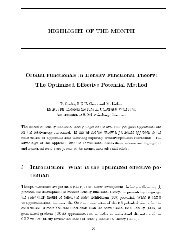You also want an ePaper? Increase the reach of your titles
YUMPU automatically turns print PDFs into web optimized ePapers that Google loves.
Linear-scaling DFT<br />
and the SIESTA method<br />
Emilio Artacho<br />
Department of Earth Sciences<br />
University of Cambridge
DFT: successful but heavy<br />
• Computationally much more expensive than<br />
empirical atomic simulations<br />
• Several thousand atoms in massively parallel<br />
supercomputers<br />
!<br />
• Computational load ~ N 3<br />
" n<br />
" m<br />
= " n<br />
*<br />
# ( r )" m<br />
( r )d 3 r = $ n,m<br />
An order of magnitude increase in computer<br />
power allows a mere doubling of system size
LINEAR SCALING<br />
CPU<br />
load<br />
~ N 3<br />
Early<br />
90’s<br />
~ N<br />
~ 100<br />
N (# atoms)<br />
G. Galli and M. Parrinello, Phys. Rev Lett. 69, 3547 (1992)
Linear-scaling KS-DFT methods<br />
• LCAO: - Gaussian based + QC machinery<br />
G. Scuseria (GAUSSIAN),<br />
M. Head-Gordon (Q-CHEM)<br />
M. Challacombe<br />
- Numerical atomic orbitals (NAO)<br />
SIESTA<br />
S. Kenny &. A Horsfield (PLATO)<br />
- Gaussian with hybrid machinery<br />
J.Vandevondele, J.Hutter, M.Parrinello (CP2K)<br />
• Bessel functions in ovelapping spheres<br />
P. Haynes & M. Payne<br />
• B-splines in 3D grid (finite-elements)<br />
D. Bowler, E. Hernandez & M. Gillan (CONQUEST)<br />
• Grid-based (plane-wave like) methods<br />
J. Bernholc (finite differences, “nearly order-N”), Fattebert<br />
A.Mostofi, C.Skylaris, P.Haynes, M.Payne (FFT-box, ONETEP)
Orbital-free linear-scaling DFT<br />
• Directly propose an approximate energy functional of<br />
the density<br />
• Difficulty: Kinetic energy functional. No ψ<br />
KS<br />
n for<br />
(and local pseudopotentials)<br />
• Linear scaling & extremely efficient<br />
(as empirical potentials)<br />
T = " h2<br />
2<br />
occ<br />
%<br />
n<br />
# 2 $ n<br />
• Simple metals<br />
!<br />
Paul Madden, Emily Carter & collaborators
TWO STEPS IN KS-DFT<br />
two different problems for linear scaling<br />
• Given a Hamiltonian, H ,<br />
obtain Ground State properties<br />
92-94 fever<br />
tight binding<br />
• Obtain H (and S) matrices<br />
(selfconsistently)<br />
- Long range interactions<br />
(electrostatics)<br />
- The rest (T,V xc , S…)<br />
Since 95<br />
DFT, HF, etc
HARTREE (electrostatics)<br />
• SIESTA (and others): real-space grids<br />
FFT, Multigrid (Numerical Recipes)<br />
• Quantum Chemistry: Fast multipoles<br />
Head-Gordon<br />
Scuseria<br />
Multigrid allows 0D, 1D, 2D & 3D bound cond<br />
and implicit solvers, Poisson-Boltzmann etc.
KEY: LOCALITY<br />
Large system<br />
x 2<br />
“Divide and Conquer”<br />
W. Yang, Phys. Rev. Lett. 66, 1438 (1992)
SIESTA method<br />
Linear-scaling DFT based on<br />
NAOs (Numerical Atomic Orbitals)<br />
P. Ordejon, E. Artacho & J. M. Soler , Phys. Rev. B 53, R10441 (1996)<br />
•Born-Oppenheimer (relaxations, mol. dynamics)<br />
•DFT<br />
(LDA, GGA: BLYP, PBE, RPBE, revPBE)<br />
•Pseudopotentials (norm conserving, factorised)<br />
•Numerical atomic orbitals as basis (finite range)<br />
•Numerical evaluation of matrix elements (3D grid)<br />
Implemented in the SIESTA program (and others)<br />
J. M. Soler, E. Artacho, J. D. Gale, A. Garcia, J. Junquera, P. Ordejon &<br />
D. Sanchez-Portal, J. Phys.: Condens. Matter 14, 2745 (2002)<br />
http://www.uam.es/siesta
Finite-support atomic orbitals as basis<br />
s<br />
p<br />
d<br />
f<br />
Strictly localised<br />
(zero beyond cut-off radius)
Hard confining potentials<br />
A single parameter<br />
Energy shift<br />
E. Artacho et al. Phys. Stat. Solidi (b) 215, 809 (1999)<br />
Fireballs<br />
O. F. Sankey & D. J. Niklewski,<br />
Phys. Rev. B 40, 3979 (1989)<br />
Convergence vs Energy shift of<br />
Bond lengths Bond energies<br />
BUT:<br />
A different cut-off radius for<br />
each orbital
Soft confining potentials<br />
1 3 5 7<br />
r (a.u.)<br />
1 3 5 7<br />
r (a.u.)<br />
• Better basis, variationally, & other results<br />
• Removes the discontinuity in the derivative<br />
J. Junquera, O. Paz, D. Sanchez-Portal & E. Artacho, Phys. Rev. B, 64, 235111 (2001)<br />
E. Anglada, J. M. Soler, J. Junquera & E. Artacho, Phys. Rev. B 66, 205101 (2002)
Multiple-zeta<br />
E. Artacho et al. , Phys. Stat. Solidi (b) 215, 809 (1999).
Polarization<br />
E. Artacho et al. , Phys. Stat. Solidi (b) 215, 809 (1999).
Linear-scaling matrix-element<br />
calculations<br />
FINITE SUPPORT BASIS FUNCTIONS<br />
S µ"<br />
,T µ"<br />
,V µ"<br />
PS,nl<br />
Two-centre integrals<br />
1D Numerical (tabulated)<br />
!<br />
!<br />
V xc µ"<br />
(#),V Hartree NA<br />
µ"<br />
($#),V µ"<br />
atoms<br />
3D integral in finite real-space grid<br />
!<br />
atoms<br />
&<br />
n<br />
"# $ # % # n<br />
atomic<br />
V NA " #{<br />
V PS,local $V Hartree (% atomic n<br />
)}<br />
n
!<br />
Grid integrations<br />
. . . . . . . . . . . . . .<br />
. . . . . . . . . . . . . .<br />
. . . .<br />
"<br />
. . . . . . . . . .<br />
. . . . . µ<br />
( r )<br />
. . . . . . . . .<br />
. . . . . . . . . . . . . .<br />
. . . . . . . . . . . . . .<br />
. . . . . . . . ". (. r r ) #<br />
. . . .<br />
. . . . . . . . . . . . . .<br />
. . . . . . . . . . . . . .<br />
Finite-range orbitals => Lists of points<br />
!<br />
Sparse matrices
Eggbox<br />
50 Ry<br />
4.4 Bohr<br />
Common to<br />
many<br />
methods!<br />
Breaking of translational invariace with 3D grid:<br />
- Grid-cell sampling (JM Soler et al JPCM 2002)<br />
- Filtering (E Anglada & JM Soler, PRB 2006)
Solving H (diagonalising)<br />
Nearsightedness principle<br />
Implies localisation:<br />
W. Kohn, Phys. Rev. Lett. 76, 3168 (1996)<br />
"( r r , r # r )<br />
"( r r # r<br />
R )<br />
' '' % 0<br />
r $ r #%&<br />
& && $ 0<br />
r # R r<br />
$%<br />
Wannier-like unitary transformations of eigenvectors:<br />
!<br />
localised basis of occupied space<br />
!
Linear-scaling solution<br />
!<br />
!<br />
• Search directly for localised quantities:<br />
-<br />
E BS<br />
"<br />
occ<br />
$ # n<br />
= E %( r<br />
n<br />
[ r , r &)]<br />
- by minimising E<br />
E BS<br />
= E<br />
[{ }]<br />
" ( r r ) i<br />
• Make them strictly local (finite support)<br />
(the approximation is here)
Functional of LWFs<br />
Where H and S are the overlap and Hamiltonian matrices in<br />
the basis of the (unknown) localised wave functions ϕ i .<br />
E. B. Stechel, A. R. Williams & P. J. Feibelman, Phys. Rev. B 49, 10088 (1994)<br />
!<br />
E BS<br />
J.-L. Fattebert & J. Bernholc, Phys. Rev. B 62 1713 (2000)<br />
The inverse of the overlap matrix can been avoided:<br />
E BS<br />
[{" }] i<br />
= 2 Tr{ S #1 H}<br />
[ ] = 2 Tr 2 # S<br />
{" } i<br />
{ }<br />
( )H<br />
P. Ordejon et al. Phys. Rev. B 48, 14646 (1993)<br />
F. Mauri & G. Galli, Phys. Rev. B 50, 4316 (1994)<br />
!<br />
The functionals are different but equal at the minimum
Localised solutions<br />
R c
Problem: local minima<br />
Excess charge<br />
on C atoms<br />
Slab of 16 layers of diamond<br />
Kim, Mauri and Galli, PRB 52, 1640 (1995)
Local minima: a way to see it<br />
Consider a square lattice with<br />
• 4 electrons per atom<br />
• 4 bonds surrounding each atom<br />
• Each bond described by a LWF<br />
• => 2 LWF per atom<br />
• Distribute: each atom “donates” 2<br />
bonds and “receives” 2
Local minima: a way to see it<br />
Consider a square lattice with<br />
• 4 electrons per atom<br />
• 4 bonds surrounding each atom<br />
• Each bond described by a LWF<br />
• => 2 LWF per atom<br />
• Distribute: each atom “donates” 2<br />
bonds and “receives” 2
Kim, Mauri & Galli’s functional<br />
Minimise the following varying φ i (LWF’s)<br />
It removes problem of local minima but<br />
requires predetermination of Fermi level<br />
Kim, Mauri and Galli, PRB 52, 1640 (1995)
KIM’s eta & ill-conditioning<br />
Effect of eta.<br />
Need to predefine it<br />
Ill-conditioning: Minimisation algorithm (CG) prop to<br />
Condition Number: Max curvature / Min curvature<br />
(problem common to many of the schemes)
Other linear-scaling solvers<br />
• Divide & Conquer (W. Yang)<br />
• Li, Nunes, Vandebilt (LNV)<br />
(and variations)<br />
[ ]<br />
E = E "( r r , r r ')<br />
BS<br />
• Goedecker’s (two) (Projecting onto Occupied space)<br />
!<br />
• Energy renormalisation group (ERG, Baer et al)<br />
METALS
Actual linear scaling<br />
Pentium III 800 MHz<br />
(single processor)<br />
1 Gb of RAM<br />
c-Si supercells, single-ζ<br />
512.000 atoms in 256 nodes<br />
(Julian Gale)
http://www.uam.es/siesta
No DC conduction in λ-DNA<br />
P. J. de Pablo et al. PRL 2000<br />
E. Artacho et al., Mol. Phys. 2003<br />
But possible polaron conduction in dry poly dG-poly dC (A-DNA)<br />
S. Alexandre, E. Artacho, J.M. Soler & H. Chacham, PRL 2003<br />
HOMO band (blue)<br />
LUMO band (red)<br />
Hole polarons:<br />
E binding = 0.3 eV<br />
Very localised<br />
Move along the<br />
HOMO band
Inhibition of cyclin-dependent kinases<br />
enzymes relevant to cell replication (and to cancer)<br />
L. Heady et al., J. Medic. Chem.2006
Geobacter pili’s pilin (geo-bio-nano!)<br />
Soil bacteria feeding from ferrous minerals by electron transfer<br />
Ambient (fluid) conditions<br />
nA, 0.1 G Ohm<br />
G. Reguera et al. Nature 435, 1098 (2005)<br />
G. Feliciano, A. J. R. da Silva, G. Reguera & EA
Candidate material for spintronics<br />
a<br />
20 ì m<br />
B,M<br />
LSMO<br />
[100]<br />
b<br />
CNT<br />
LSMO<br />
c<br />
LSMO<br />
x<br />
CNT<br />
300 nm<br />
Magnetoresistance in device made of LSMO<br />
strips bridged by CNT<br />
L. E. Hueso et al, Nature (in press; cond-mat/0511697)
Magnetoresistance measurements<br />
50<br />
40<br />
5 K<br />
25 mV<br />
a<br />
V (mV)<br />
0 100 200 300 400 500<br />
b<br />
MC (%)<br />
30<br />
20<br />
10<br />
25 mV<br />
5 K<br />
0<br />
-150 -100 -50 0 50 100 150<br />
B (mT)<br />
0 20 40 60 80 100 120<br />
T (K)<br />
Varying external B field, change relative spin orientation,<br />
important change in resistance<br />
L. E. Hueso et al, Nature 2007
Electronic structure at the LSMO/CNT interface<br />
(explicit doping; same supercell plus (6,6) CNT)
Electronic structure at the LSMO/CNT interface<br />
(explicit doping; same supercell plus (6,6) CNT)
GGA: LSMO (001) surface. x = 1/3<br />
• Supercell: Slab 2x4 (x5.5 layers + vacuum) . 224 atoms, 48 Mn. (exposing<br />
MnO 2<br />
layers on both sides)<br />
• Explicit doping: 27 La, 13 Sr (disordered, 1 realisation)
Tran<strong>Siesta</strong> (J. L. Mozos, M. Brandbyge, K. Stokbro, J. Taylor & P. Ordejon)<br />
Utility in <strong>Siesta</strong> for ballistic electron transport<br />
Non-equilibrium Green’s functions (Keldysh)<br />
Conduction through dithiol<br />
Pulling Au atoms alters conductance<br />
Transmittance vs energy<br />
R. J. C. Batista, P. Ordejon, H. Chacham & E. Artacho, PRB RC 2006<br />
Transport / energetics / geometry on the same footing<br />
But also LDA+U, Pseudo-SIC, Accelerated dynamics, STM, etc
Acknowledgments<br />
Daniel Sanchez-Portal (UPV San Sebastian)<br />
Pablo Ordejon (ICMAB Barcelona)<br />
Jose M. Soler (UAM Madrid)<br />
Julian Gale<br />
(Curtin, Australia)<br />
Alberto Garcia (UPV Bilbao)<br />
Richard Martin (U. Illinois, Urbana)<br />
Javier Junquera (U. Santander)<br />
Oscar Paz<br />
(UAM Madrid)<br />
Eduardo Anglada (UAM Madrid)<br />
SIESTA<br />
gang<br />
Miguel Pruneda, Valeria Ferrari, Nicola Spaldin, Ben Simons,<br />
Peter Littlewood<br />
Luis Hueso, Neil Mathur<br />
Ronaldo Batista, Helio Chacham<br />
Gustavo T. Feliciano, Antonio J. R. da Silva
Summary<br />
• Essentials of linear-scaling DFT around SIESTA<br />
• Exploiting locality explicitly (except for Hartree)<br />
• Still much to do (metals, generality, robustness)<br />
• Larger sizes open up to calculations<br />
• BUT: facing the complexity barrier!



